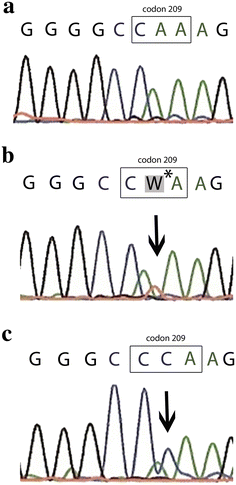Activating mutations of the GNAQ gene: a frequent event in primary melanocytic neoplasms of the central nervous system
- PMID: 19936769
- PMCID: PMC2831181
- DOI: 10.1007/s00401-009-0611-3
Activating mutations of the GNAQ gene: a frequent event in primary melanocytic neoplasms of the central nervous system
Abstract
Primary melanocytic neoplasms of the central nervous system (CNS) are uncommon neoplasms derived from melanocytes that normally can be found in the leptomeninges. They cover a spectrum of malignancy grades ranging from low-grade melanocytomas to lesions of intermediate malignancy and overtly malignant melanomas. Characteristic genetic alterations in this group of neoplasms have not yet been identified. Using direct sequencing, we investigated 19 primary melanocytic lesions of the CNS (12 melanocytomas, 3 intermediate-grade melanocytomas, and 4 melanomas) for hotspot oncogenic mutations commonly found in melanocytic tumors of the skin (BRAF, NRAS, and HRAS genes) and uvea (GNAQ gene). Somatic mutations in the GNAQ gene at codon 209, resulting in constitutive activation of GNAQ, were detected in 7/19 (37%) tumors, including 6/12 melanocytomas, 0/3 intermediate-grade melanocytomas, and 1/4 melanomas. These GNAQ-mutated tumors were predominantly located around the spinal cord (6/7). One melanoma carried a BRAF point mutation that is frequently found in cutaneous melanomas (c.1799 T>A, p.V600E), raising the question whether this is a metastatic rather than a primary tumor. No HRAS or NRAS mutations were detected. We conclude that somatic mutations in the GNAQ gene at codon 209 are a frequent event in primary melanocytic neoplasms of the CNS. This finding provides new insight in the pathogenesis of these lesions and suggests that GNAQ-dependent mitogen-activated kinase signaling is a promising therapeutic target in these tumors. The prognostic and predictive value of GNAQ mutations in primary melanocytic lesions of the CNS needs to be determined in future studies.
Figures


Similar articles
-
GNA11 and N-RAS mutations: alternatives for MAPK pathway activating GNAQ mutations in primary melanocytic tumours of the central nervous system.Neuropathol Appl Neurobiol. 2013 Jun;39(4):417-25. doi: 10.1111/j.1365-2990.2012.01288.x. Neuropathol Appl Neurobiol. 2013. PMID: 22758774
-
Mutations in g protein encoding genes and chromosomal alterations in primary leptomeningeal melanocytic neoplasms.Pathol Oncol Res. 2015 Apr;21(2):439-47. doi: 10.1007/s12253-014-9841-3. Epub 2014 Oct 15. Pathol Oncol Res. 2015. PMID: 25315378
-
Targeted next generation sequencing reveals unique mutation profile of primary melanocytic tumors of the central nervous system.J Neurooncol. 2016 May;127(3):435-44. doi: 10.1007/s11060-015-2052-2. Epub 2016 Jan 7. J Neurooncol. 2016. PMID: 26744134 Free PMC article.
-
Primary melanocytic tumors of the central nervous system: a review with focus on molecular aspects.Brain Pathol. 2015 Mar;25(2):209-26. doi: 10.1111/bpa.12241. Brain Pathol. 2015. PMID: 25534128 Free PMC article. Review.
-
Improved discrimination of melanotic schwannoma from melanocytic lesions by combined morphological and GNAQ mutational analysis.Acta Neuropathol. 2010 Dec;120(6):755-64. doi: 10.1007/s00401-010-0749-z. Epub 2010 Sep 24. Acta Neuropathol. 2010. PMID: 20865267 Free PMC article. Review.
Cited by
-
SISTEMA: A large and standardized collection of transcriptome data sets for human pluripotent stem cell research.iScience. 2021 Jun 24;24(7):102767. doi: 10.1016/j.isci.2021.102767. eCollection 2021 Jul 23. iScience. 2021. PMID: 34278269 Free PMC article.
-
S-100-negative, GNA11 mutation-positive intramedullary meningeal melanocytoma of the thoracic spine: A radiographic challenge and histologic anomaly.Surg Neurol Int. 2021 Jun 28;12:315. doi: 10.25259/SNI_416_2021. eCollection 2021. Surg Neurol Int. 2021. PMID: 34345456 Free PMC article.
-
Activating CYSLTR2 and PLCB4 Mutations in Primary Leptomeningeal Melanocytic Tumors.J Invest Dermatol. 2017 Sep;137(9):2033-2035. doi: 10.1016/j.jid.2017.04.022. Epub 2017 May 10. J Invest Dermatol. 2017. PMID: 28499758 Free PMC article. No abstract available.
-
Clinico-genomic features predict distinct metastatic phenotypes in cutaneous melanoma.bioRxiv [Preprint]. 2025 Jan 27:2025.01.24.633441. doi: 10.1101/2025.01.24.633441. bioRxiv. 2025. PMID: 39975034 Free PMC article. Preprint.
-
Mutations in GNA11 in uveal melanoma.N Engl J Med. 2010 Dec 2;363(23):2191-9. doi: 10.1056/NEJMoa1000584. Epub 2010 Nov 17. N Engl J Med. 2010. PMID: 21083380 Free PMC article.
References
-
- Balmaceda CM, Fetell MR, O’Brien JL, Housepian EH. Nevus of Ota and leptomeningeal melanocytic lesions. Neurology. 1993;43:381–386. - PubMed
-
- Bisceglia M, Carosi I, Fania M, Di CA, Lomuto M. Nevus of Ota. Presentation of a case associated with a cellular blue nevus with suspected malignant degeneration and review of the literature. Pathologica. 1997;89:168–174. - PubMed
-
- Brat DJ, Perry A. Melanocytic lesions. In: Louis DN, Ohgaki H, Wiestler OD, Cavenee WK, editors. WHO classification of tumours of the central nervous system. 4. Lyon: IARC; 2007. pp. 181–183.
MeSH terms
Substances
LinkOut - more resources
Full Text Sources
Other Literature Sources
Medical
Research Materials
Miscellaneous

